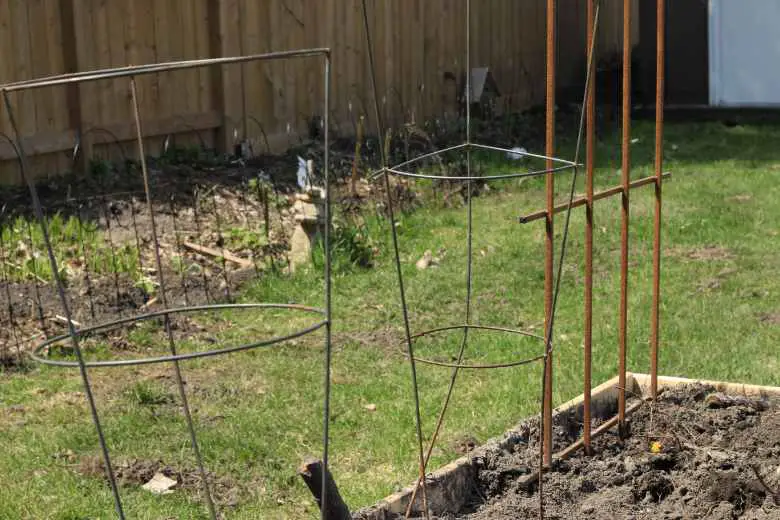Green beans are a popular vegetable to grow in home gardens They are easy to grow, productive, and delicious when harvested fresh. Many home gardeners use a trellising system for their green beans, to keep the plants upright and make harvesting easier A common question is whether tomato cages can be used effectively to trellis green beans. In this article, we’ll take an in-depth look at using tomato cages for green beans.
What are the Benefits of Using Tomato Cages for Green Beans?
There are several potential benefits to using tomato cages for green beans:
-
Tomato cages provide built-in support You don’t need to build a trellising system from scratch Just stick the tomato cage in the ground and you’ve got built-in trellising ready to go, This saves time and effort,
-
Cages keep plants upright and off the ground. This prevents rot and disease and makes it much easier to spot and harvest beans. Beans grown off the ground in cages tend to produce higher yields.
-
Cages keep plants contained in a tight space. This allows you to fit more green bean plants into a smaller space in your garden.
-
Cages keep beans clean and easy to harvest. Beans grown inside the cages don’t sit on the soil surface and are less likely to rot.
What Type of Tomato Cages Work Best?
Sturdy tomato cages with larger openings work best for green beans. Look for beefy cages that are at least 36-48 inches tall, with openings of 4-6 inches. This gives plants enough vertical room to grow and makes it easy to spot and harvest beans inside the cages. Lightweight, flimsy cages are too unstable and cages with small openings make harvesting difficult.
Square or rectangular cages are ideal, as they make better use of space when placed close together in rows. Round cages leave empty space between plants that could otherwise be used.
You can also stack two smaller cages on top of each other to make a sturdier, taller cage for green beans if needed.
How to Use Tomato Cages for Green Beans
Using tomato cages for green beans takes a bit of planning, but is easy to implement:
-
Stick cages into the ground where you want plants. Space 18-24 inches apart down rows.
-
Plant 2-4 green bean seeds around the inside and outside base of each cage. Plant seeds 4 inches apart.
-
Once sprouted, thin to 2-3 of the healthiest seedlings per cage. Remove others.
-
Add a trellis cross bar about halfway up cages if desired, to help support heavy bean growth.
-
As plants grow, gently weave and train stems through cage openings, maintaining even spacing on all sides.
-
Rotate cages every 2-3 years to different beds to prevent disease buildup.
-
Mulch around cages to retain moisture and reduce weeds. Keep soil moist, especially during flowering and pod set.
-
Harvest beans promptly when ready to encourage further pod production.
What Types of Green Beans Work Best?
Bush type green beans are best suited for growing inside tomato cages. Pole beans grow too large and heavy. Good bush bean varieties for cages include:
-
Provider – Heavy yields of 5-6 inch long pods. Concentrated harvest time.
-
Contender – Reliable and productive. 5 inch pods.
-
Jade – Prolific, bright green 6 inch pods. Great for canning.
-
Hialeah – Impressive yields, 5 inch pods. Heat tolerant.
-
Bronco – Vigorous bush plants, 5 inch pods. Disease resistant.
Common Problems and Solutions
Growing green beans in tomato cages can work very well, but there are some common issues to look out for:
Not enough support – Beefy cages and cross-bracing is needed to support mature plants full of ripe beans. Lightweight cages will topple.
Overcrowding – Don’t plant beans too densely or cages will be too crowded. Space plants appropriately.
Leaning and falling cages – Cages must be staked into the ground very firmly, at least 6 inches deep, or they’ll lean and fall over as plants get large.
Difficult harvesting – Overgrown tangled plants make picking hard. Prune excess growth if needed for easy access.
Lower yields – Cages that are too small can restrict bean production. Make sure to use sufficiently sized cages.
The Verdict
With the right cages and techniques, tomato cages can be extremely effective for trellising green beans. The cages offer built-in support and make harvesting easier and more productive. Select bush varieties suited to container growing, make sure to plant an appropriate density, and use sufficiently sized sturdy cages for best results. With a bit of trial and error, tomato cages can become a handy trellising solution for green beans in spaces large and small.

Top 5 Garden Trellises that Work!!! | Gardening | Homesteading
FAQ
What other vegetables can you use tomato cages for?
Can tomato cages be used for other plants?
Can I use a tomato cage as a trellis?
